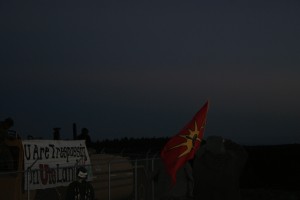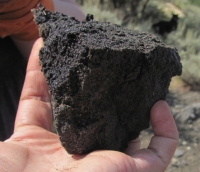We had prepared and arranged for one of the defendants to give a customary statement to the court on behalf of the defendants about why they did what we did, why we do what we do, and why we must continue. The judge denied us his audience. Instead this statement was read to the news media outside the courtroom.
The Moral Imperative to Halt Tar Sands Mining
Last summer, twenty-five people were arrested for participating in acts of civil disobedience to halt construction of U.S. Oil Sands’ tar sands mine. We felt we had no choice but to take such action because of the blatant human rights violations that tar sands mining causes.
Tar sands is essentially naturally occurring asphalt. Extracting a low-grade oil out of it demands a tremendous amount of energy and water, making it a massive contributor to climate change as well as water and air pollution. Separating the bitumen from the rock mobilizes dangerous toxins that are present in substantial amounts, like mercury and arsenic.
In Canada, where tar sands mining has destroyed an area the size of Florida, it has polluted the Athabasca River with substances causing cancer, birth defects, and mutations in parts per trillion.
Indigenous people in the community downriver are getting rare cancers at an alarming rate, with cases occurring at a 30% higher rate than expected. Marginalized communities typically face the most severe environmental injustices, and we fear that this will be the case for indigenous communities who rely on the Colorado River and live downstream from the tar sands mines.
These communities are already dealing with many violations of their human rights from uranium extraction, water depletion, and a multitude of other issues. Their right to health, along with that of the 40 million water drinkers who rely on the Colorado, is being sacrificed for corporate profit. The same will happen to those in the airshed of the mining area and the refineries in Salt Lake City where the bitumen is expected to be processed.
Tar sands mining also uses copious amounts of water. The state of Utah takes at face value U.S. Oil Sands’ claims that it will use minimal water, when every tar sands project in existence uses massive amounts of water. Meanwhile, U.S. Oil Sands is already using precious deep aquifer water for its operations—water that should be reserved for sustaining life in a drying world. It has been well-documented that the Colorado’s flow is steadily dwindling, due to catastrophic climate change, which tar sands mining itself exacerbates. We can’t allocate more water to industrial use when the river has less water to give every year. We need to think of all the people downriver who rely on that water for sustenance. Because 15% of our nation’s food is grown using Colorado River water, giving more of our water to industry would endanger our food security as well.
Further, catastrophic climate change is real. Virtually all of the scientific community accepts it, yet our government continues to permit and subsidize projects that send us further toward climate collapse. Tar sands has a more detrimental climate impact than just about any other project, producing three times as much greenhouse gas as regular crude. It doesn’t matter if the School and Institutional Trust Lands Administration (SITLA) manages to raise 2% of the public school budget this year if we’re leaving our children with a doomed world.
Once the land is strip-mined, its complex ecosystems will take perhaps centuries to return. We believe we must not leave a vast area of the East Tavaputs Plateau a tar sands wasteland. Despite U.S. Oil Sands’ claims, there is no way they can bring the land back with anything close to the complexity of this diverse high desert and canyon ecosystem. We maintain that corporations have no right to destroy places like Utah’s Book Cliffs forever.
On June 12, 2014, the EPA issued a directive to U.S. Oil Sands saying that USOS needs additional permitting because the strip mine is on traditional Uintah and Ouray Reservation land.
Nobody has held U.S. Oil Sands to this requirement—on the contrary, the company has continued clear-cutting, blasting, and bulldozing the land without securing the required permits.
After careful consideration, we came to the conclusion that we have the moral imperative, as residents who rely on the air, water, and land of this region, to protect these resources when our government refuses to serve as steward of them on behalf of the people.
We believe we must protect this land and these resources for future generations. SITLA is entrusted with managing this land for the long-term benefit of the public schools, but instead is sacrificing it for short-term gains, which stands in diametrical opposition to its mission. Over the past several years, we and various other organizations have pursued legal solutions such as a challenge to U.S. Oil Sands’ wastewater dumping permit, discussions with SITLA, and public rallies, to no avail. Our government’s insistence on looking the other way as tar sands strip mining in Utah jeopardizes our future led us to take civil disobedience in order to persuade our government to protect human rights over corporate profits. Only after serious deliberation did we choose to jeopardize our own liberty by using the age-old tactic of nonviolent civil disobedience for the sake of our future and all the generations to come.









